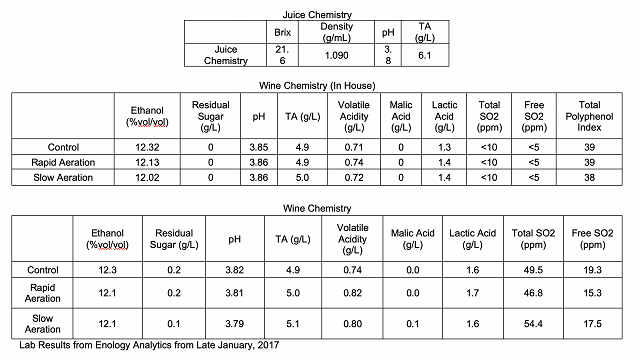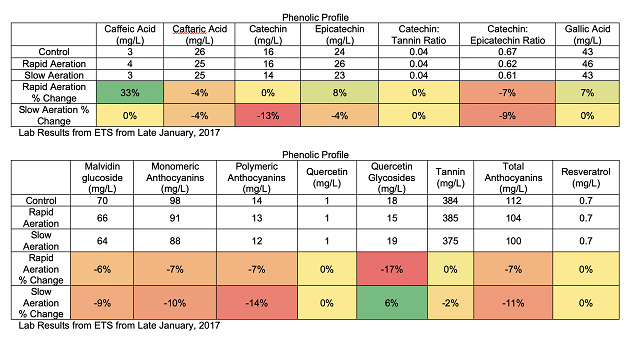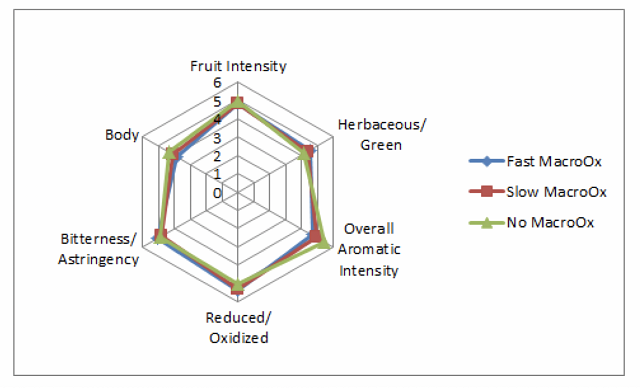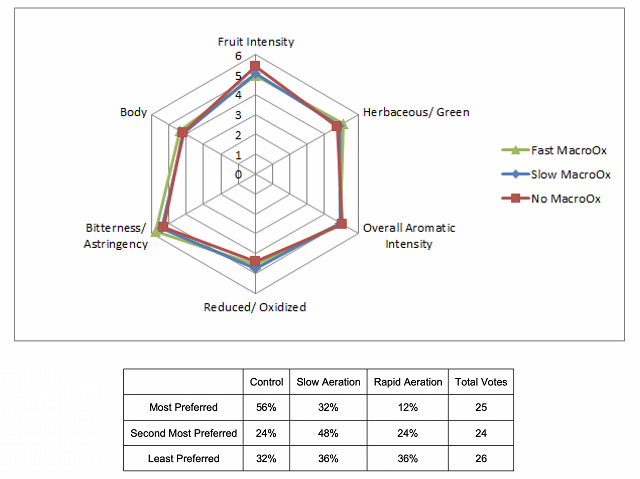The Effect of Macro-Oxygenation on Phenolic and Sensory Attributes of Red Wine (2016)
Benoit Pineau
Pollak Vineyards
Summary
This study examines the effect of different rates of macro-oxygenation on the phenolic and sensory qualities of Cabernet Franc. Grapes were harvested on the same day but kept separate, and all treatments between lots were kept the same except that one T Bin received no macro-oxygenation, one T Bin received a rapid macro-oxygenation to attain 5mg/L added oxygen after punchdowns (<1 hour aeration), and another T Bin received a slow aeration to attain 5mg/L added oxygen after punchdowns (3-4 hours aeration). Oxygen was added after punchdowns. No major chemical or phenolic differences are noticeable between treatments, except that phenolics slightly decreased in aerated wines. Macro-oxygenation tended to lower Overall Aromatic Intensity, with rapid macro-oxygenation tending to lower it the most. There were slight tendencies for macro-oxygenation to increase oxidation qualities and lower Fruit Intensity, and rapid macro-oxygenation tended to have slightly higher Bitterness/Astringency. These tendencies, however, were very weak. In general, people tended to prefer wine made without macro-oxygenation, and least preferred the wine made with rapid macro-oxygenation. Because these trends were very weak, this study should be repeated a few more times before making strong conclusions about macro-oxygenation.
Introduction
Different oxygenation regimes during fermentation are thought to affect the phenolic extraction, structure, and stability of finished wine. Aerating red wines during and after fermentation increases the amount of polymeric pigment in wines. Aerating younger wines tends to be more effective than older wines, since in younger wines the majority of phenolic compounds are still monomeric. However, too much aeration in a wine’s life (especially later in its life) can cause precipitation of polymeric pigments and tannin (Zoecklein 2001). Thus, finding ways to control the rate and timing of oxygenation throughout a wine’s life is very important to achieving high quality wines.
Macro-oxygenation during fermentation may be a technique to alter these factors with greater control. Macro-oxygenation can be performed as a “single dose”, bringing in around 6mg/L oxygen to fermenting must in a period of 1-4 hours. It can also be performed continuously, at 0.5mg/L per hour between 1.080 and 1.020 density (Deltel 2007).
Must exposed to oxygenation during fermentation often shows decreased levels of anthocyanins (Cheynier et al 1997), but it is unclear if this is due to increases in yeast population which binds anthocyanins or due to enzymatic oxidation. Additionally, exposing non-sulfited must to oxygenation early on results in losses of anthocyanins, phenolics, and hydroxycinnamic acids. This study did not investigate the formation of polymeric pigment, however (Castellari et al. 1998).
Most oxygen during macro-oxygenation is consumed by the yeast (Deltel 2007). However, this aspect may also cause blooms of unwanted bacteria and yeast species, and may increase volatile acidity. For example, aeration of wines which have an inoculum of Brettanomyces can promote growth (Zoecklein 2004), although this is commonly a concern towards the end of fermentation and during aging. Macro-oxygenation may help reduce sulfur off odors during fermentation without reducing fruit aromas or oxidizing the wine (Deltel 2007). However, it is very likely that aeration can also help keep sulfur compounds in solution, temporarily oxidizing these compounds to their less volatile disulfide forms. This study examines the impact of different macro-oxygenation regimes during fermentation on these aspects in Cabernet Franc.
Results and Discussion
No major chemical or phenolic differences are noticeable between treatments, except that phenolics slightly decreased in aerated wines.


This project was tasted on March 8 and March 15. Descriptive analysis on March 8 found that the wine produced with no macro-oxygenation showed a strong tendency to be higher in Overall Aromatic Intensity than the wines produced with macro-oxygenation. Slow macro-oxygenation had higher Overall Aromatic Intensity than fast macro-oxygenation, but this was a weak trend. No other major trends could be seen. In general, people tended to prefer the wine produced from fast macro-oxygenation the least.


For the March 15 tasting, no major trends could be seen with the descriptors used in this study. Fast macro-oxygenation tended to slightly increase Bitterness/Astringency, and macro-oxygenation in general tended to slightly increase Oxidation characteristics and lower Fruit Intensity. In general there was a slight preference for wine which had not been macro-oxygenated. The wine which underwent rapid macro-oxygenation was the least preferred.

In general, macro-oxygenation tended to lower Overall Aromatic Intensity, with rapid macro-oxygenation tending to lower it the most. There were slight tendencies for macro-oxygenation to increase oxidation qualities and lower Fruit Intensity, and rapid macro-oxygenation tended to have slightly higher Bitterness/Astringency. These tendencies, however, were very weak. In general, people tended to prefer wine made without macro-oxygenation, and least preferred the wine made with rapid macro-oxygenation. Because these trends were very weak, this study should be repeated a few more times before making strong conclusions about macro-oxygenation.
Methods
A lot of Cabernet Franc grapes from the same block were harvested on 10/5 and stored overnight in refrigeration. The grapes were destemmed and crushed together, and placed into three separate but identical fermentation T-bins at 5.4hL per T-bin. On during processing 6g/hL sulfur dioxide, 30mL/T Color Pro, 40g/hL FT Rouge, and 0.5g/L tartaric acid. On 10/7, 10% of the must volume was removed through saignée to reduce the must volume to 4.9hL/T-bin. These bins underwent a 2 day cold soak and were inoculated with 20g/hL Premier Cru Yeast on 10/8. All fermentation practices, additions, punchdowns, etc. were identical between tanks. The musts were chaptalized on 10/12 with 1.11kg/hL sugar. The treatments for each T bin were as follows:
- T Bin 1 : Control: 2 Punch Down / Day (no air)
- T Bin 2 : Rapid Aeration: 2 Punch Down / Day. Addition (<1hours) of 5mg/L O2 / PD up to approximately 1.060 specific gravity. (addition of O2 after PD)
- T Bin 3 : Slower Aeration: 2 Punch Down / Day. Addition (3-4hours) of 5mg/L O2 / PD up to approximately 1.060 specific gravity. (addition of O2 after PD)
These treatments were achieved by bubbling ambient air (room air) through a stone into the wine after each punchdown to achieve 5mg/L dissolved oxygen until the wine reached a specific gravity of approximately 1.060. Oxygenation was terminated after the first punchdown on 10/12. Dissolved oxygen was not measured.
Maceration continued for the same amount of time between treatments, and all three bins were pressed separately on the same day (10/26) and drained into separate aging vessels. Free run and press fractions were mixed for each project.
Once separated into their barrels, the wine was treated with 0.8g/L tartaric acid and inoculated with malolactic bacteria on 10/27. 0.3mL/L lactic acid was added to the aging wines on 11/9. Malolactic fermentation completed on 11/15/2016, upon which the wine was microbially stabilized with 55ppm sulfur dioxide. All other treatments between vessels such as rackings, stirrings, etc. were identical.
In order to balance the data set to perform statistical analysis for descriptive analysis on the March 8 tasting, any judge who had not fully completed the descriptive analysis ratings were removed. In order to then make the amount of judges between groups equivalent, one judge from group 1 was transferred to group 3, and another judge from group 2 was eliminated. This resulted in a final data set of 3 groups, each with 10 judges (considered as replications within groups, and groups were considered as assessors). Data was analyzed using Panel Check V1.4.2. Because this is not a truly statistical set-up, any results which are found to be statistically significant (p<0.05) will be denoted as a “strong trend” or a “strong tendency,” as opposed to general trends or tendencies. The statistical significance here will ignore any other significant effects or interactions which may confound the results (such as a statistically significant interaction of Judge x Wine confounding a significant result from Wine alone). The descriptors used in this study were Fruit Intensity, Herbaceous/Green, Overall Aromatic Intensity, Reduced/Oxidized (on a scale from most reduced to most oxidized), Bitterness, and Body.
The same procedures for data analysis were used on the March 15 tasting. For the descriptive analysis in this tasting, one judge had to be removed from group 3 to result in each group having 8 judges.
References
Cheynier, V., Arellano, I.H., Souquet, J.M., and Moutounet, M. 1997. Estimation of the oxidative changes in phenolic compounds of Carignane during winemaking. Am. J. Enol. Vitic. 48:225-228.
Castellari, M., Arfelli, G., Riponi, C., and Amati, A. 1998. Evolution of phenolic compounds in red winemaking as affected by must oxygenation. Am. J. Enol. Vitic. 49:91-94.
Deltel, D. 2007. Bonnes Pratiques de Macro-oxygénation. Etude d’un cas concret pour les vins rouges. Revue des Œnologues N°125S. November.
Zoecklein, B. 2001. Controlled aeration of red wines. Enology Notes #33. http://www.apps.fst.vt.edu/extension/enology/EN/33.html.
Zoecklein, B. 2004. Brettanomyces. Enology Notes #92. http://www.apps.fst.vt.edu/extension/enology/EN/92.html
